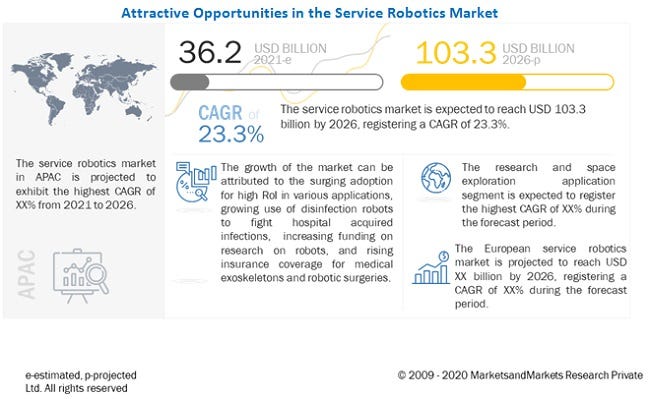Service Robotics Market with COVID-19 Impact Analysis, by Environment, Type (Professional, Personal & Domestic), Component, Application (Logistics, Inspection & Maintenance, Public Relations, Education, Personal), and Geography — Global Forecast to 2026
According to a research report “Service Robotics Market with COVID-19 Impact Analysis, by Environment, Type (Professional, Personal & Domestic), Component, Application (Logistics, Inspection & Maintenance, Public Relations, Education, Personal), and Geography — Global Forecast to 2026” published by MarketsandMarkets, the service robotics market is projected to grow from USD 36.2 billion in 2021 and is projected to reach USD 103.3 billion by 2026; it is expected to grow at a CAGR of 23.3% from 2021 to 2026. The growing adoption of robots for new applications providing high returns on investment coupled with rising use of IoT in robots for cost-effective predictive maintenance is the key factors driving the service robotics market. In addition to this, in the wake of the COVID-19 pandemic, there is an increasing need to reduce hospital-acquired infections to regularly, which has fueled the need for adoption of robots for the purpose of disinfection and sanitation.
Browse 251 market data Tables and 71 Figures spread through 376 Pages and in-depth TOC on “Service Robotics Market — Global Forecast to 2026”
[376 Pages Report] According to MarketsandMarkets, the service robotics market is projected to grow from USD 36.2 billion in 2021 to reach USD 103.3 billion by 2026; it is expected to grow at a Compound Annual Growth Rate (CAGR) of 23.3% from 2021 to 2026.
The growing adoption of robots for new applications providing high returns on investment coupled with increasing funding for research on robots is the key factors driving the service robotics market. In addition to this, in the wake of the COVID-19 pandemic, there is an increasing need to reduce hospital-acquired infections to regularly, which has fueled the need for adoption of robots for the purpose of disinfection and sanitation.
Impact of COVID-19 on service robotics market size and forecast
The emergence of the COVID-19 pandemic, a deadly respiratory disease, has now become a worldwide issue. The COVID-19 pandemic has substantially impacted the value chain of the service robotics market. The US, China, and Japan, which have been adversely affected by the pandemic, are expected to account for significant shares of the service robotics market. Many industries, such as automotive and aerospace & defense, were adversely impacted by COVID-19, but they showed resilience by the end of 2020 and began 2021 with a slight gain in growth rate. The services sector was also impacted by COVID-19, although a U-shaped recovery is expected, with gradual improvement in the global economy. The market may register a CAGR of 23.3% from 2021 to 2026.
“Hardware component of service robots is expected to have a larger share of the market compared to software component in 2021”
The hardware component will dominate the service robotics market in 2021. This can be attributed to the innovative designs needed on the hardware side. Sensors and control units on both domestic and commercial type service robots remain expensive. Operating costs for drones are often high because the batteries have to be frequently replaced if the drones are flown on a frequent basis. Batteries often contribute to a major portion to the running costs of a drone, especially when used for commercial applications. Exoskeletons remain very expensive for personal use unless some coverage is provided by the insurance. Even pool cleaning robots remain expensive today for majority of urban households. Although hardware component will have the larger share of the market, it is expected to decrease over time due to economies of scale.
About MarketsandMarkets™
MarketsandMarkets™ provides quantified B2B research on 30,000 high growth niche opportunities/threats which will impact 70% to 80% of worldwide companies’ revenues. Currently servicing 7500 customers worldwide including 80% of global Fortune 1000 companies as clients. Almost 75,000 top officers across eight industries worldwide approach MarketsandMarkets™ for their painpoints around revenues decisions.
Our 850 fulltime analyst and SMEs at MarketsandMarkets™ are tracking global high growth markets following the “Growth Engagement Model — GEM”. The GEM aims at proactive collaboration with the clients to identify new opportunities, identify most important customers, write “Attack, avoid and defend” strategies, identify sources of incremental revenues for both the company and its competitors. MarketsandMarkets™ now coming up with 1,500 MicroQuadrants (Positioning top players across leaders, emerging companies, innovators, strategic players) annually in high growth emerging segments. MarketsandMarkets™ is determined to benefit more than 10,000 companies this year for their revenue planning and help them take their innovations/disruptions early to the market by providing them research ahead of the curve.

